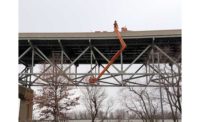
The construction of a large-scale interstate pipeline can take 18 months, while smaller, local distribution lines can take as few as six months. Each project typically is divided up into several smaller lengths called "spreads," which creates a construction assembly line that can span up to 100 miles at a time.
After each spread is cleared and graded, sections of pipe are laid on the ground along the pipeline's right-of-way. Usually between 40 ft and 80 ft long, the pipe segments have 20-in. to 40-in. diameters for interstate and gathering lines and 6-in. to 16-in. diameters for lateral distribution lines. Larger lines, which operate at between 600 and 1,000 pounds per sq in. (psi) of pressure, are made of high-strength steel pipe that has a 0.25-in. to 0.75-in. thickness.
Plastic often is used for smaller distribution lines, which operate at less than 100 psi. Located about every 100 miles along the pipeline, compressor stations boost the pressure of the natural gas as it travels through the pipe. The U.S. Dept. of Transportation mandates natural-gas trenches be at least 30 in. deep, which sometimes requires explosives to remove large rock formations. Before the pipe is placed underground, segments are welded together. The pipe is precoated with an anti-corrosion formula; as this formula interferes with welding, the segment ends are left uncoated. Before the pipe is lowered into the ground and covered, the uncoated portions are finished by hand.

